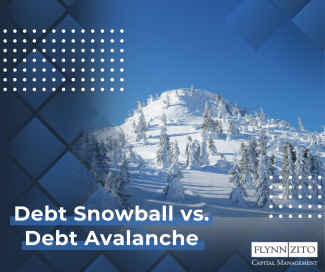
Debt Snowball vs. Debt Avalanche: The Cold Hard Facts
What would you do if you didn't have a single monthly payment each month on debt? No car, credit card bills, student loans, or even a house payment! Living a debt-free life with no monthly payments is possible for everyone, regardless of income. Eliminating your debt and managing your spending habits can be life-changing and could enhance your mental health, financial independence, and net worth.
However, if you have debt you carry month over month, the cold hard facts are:
- Debt encourages you to spend more than you can afford.
- Debt costs you money.
- Debt borrows from your future income.
- High-interest debt causes you to pay more than the item cost.
- Debt keeps you from pursuing your financial goals.
- Debt can keep you from owning a home.
- Debt can lead to stress and serious medical problems.
- Debt can hurt your marriage.
- Debt hurts your credit score.
Not all debt is bad. For example, a student loan, car loan, or mortgage is necessary to advance your future earnings, provide transportation, or provide a safe living structure. But if you finance more than you need, such as a luxury car that significantly impacts your budget and monthly payments, debt can be harmful depending on your situation.
If you would like to eliminate your debt, here are some methods that may help you as you work toward a debt-free life:
Debt Snowball method- This debt reduction strategy has you pay off your debts by starting with the smallest to the largest regardless of the interest rate. This strategy also helps change spending habits because you focus all your additional money toward debt reduction. You'll make minimum payments on the rest as you work toward snowballing the smallest debt. Start by paying off one debt first, then move to the next lowest balance debt. Here's how the Debt Snowball method works:
- Step #1- Write down your debts from the smallest to the largest.
- Step #2- Throw all your extra money (snowball) at the smallest debt and continue making the minimum payments on the rest of your debt. Your snowball payment should be the minimum plus extra such as $50, $100, or more. Once the smallest debt is gone, use the extra money to snowball the next small debt on your list.
- Step #3- Repeat snowballing your extra money at the next debt on your list while making the minimum payments on the rest until you've plowed your way through all your debt!
Debt Avalanche Method- This debt reduction strategy involves making the minimum payment on all your debt and then using any remaining money earmarked for your obligations to pay the bill with the highest interest rate. Using the debt avalanche method will save you the most in interest payments. Here's how the Debt Avalanche method works:
- Step #1- Write down your debts from the highest to the lowest interest rate.
- Step #2- Pay the minimum payment for all debts except the highest interest rate debt.
- Step #3- Use your extra money to make aggressive payments on the highest interest rate debt and once paid off, move to the next highest interest rate debt and apply both the minimum and extra each month.
The Debt Avalanche method will make your money go the furthest and save you more on interest charges. However, this method may take more time to eliminate all debt, depending on your situation.
No matter which debt elimination method you choose, making more than the minimum payment on the balance you are working toward paying off is essential. Otherwise, you will continue to accumulate interest charges. Now that you know the cold hard facts about debt and how to eliminate it, choose the appropriate method for your situation or consider discussing these options with a financial professional to help you determine a suitable course of action.
Sources:
https://www.thebalancemoney.com/reasons-debt-is-bad-960048
Important Disclosures
The opinions voiced in this material are for general information only and are not intended to provide specific advice or recommendations for any individual.
All information is believed to be from reliable sources; however LPL Financial makes no representation as to its completeness or accuracy.
This article was prepared by Fresh Finance.
LPL Tracking #1-05349226
